300 Blackout Wont Feed Lee 150 Grain Cast Bullets
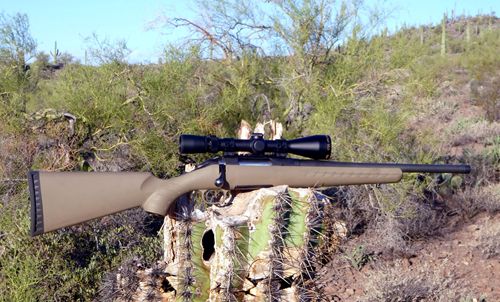
Some of us know that this caliber began life as the 300 Whisper. And if the rig fires subsonic ammo, �Whisper� is not inappropriate. My initial objective here was to develop subsonic loads. Then things escalated a bit.
Anyway, unlike in an AR platform, with a bolt gun there is no need to be concerned with functionality. Any safe ammo will work, independent of power level.
OK, to be clear, some types of projectiles will not feed from the Ruger magazine. I shot them anyway, by letting gravity rattle each round directly into the chamber. With targeting velocities not exceed about 1060 fps, lead bullets became an obvious choice. That especially so because I have the tools and equipment for casting.
In my rifle, as far as lead bullets are concerned, only the 170 grain gas-checked bullet from an old Ideal mould and the fairly new Lee 230-grainer fed reliably from the magazine.
Note that the Lee bullet does not call for a gas check. But at least a Hornady GC would �go right onto� its heel. It did not have the desired effect as accuracy suffered with my initial loads. The 230-grainer is also the only bullet tested here that would cycle an AR while still going subsonic.
You can buy Magnus lead bullets from Midsouth Shooters Supply. Except, the 100 grain version is no longer listed in their 2016 catalog. The 150s and 165s are still available for the shooter who wants to try lead, but does not want to cast their own. My cast bullets came from wheels weights, with bullets dropped from the mould right into a 5-gallon bucket of water for maximum lead hardness. That method has worked well for me for years. If accuracy is reported, it was at least 5 shots, and always at fifty steps.
Note that the 170GC bullet delivered useful accuracy with many loads tested. So I fell prey to the temptation to expand my test program. 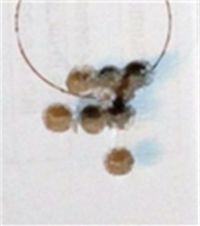
180GC with 5 grains of TRAIL BOSS punched these at 50 yds, tight enough to fit between a squirrel�s ears.
Wheel weights, by the way, dated back to a time when we could buy them from local tire stores. Under these conditions the cost of a 300BLK round with homemade cast bullet is no more than today�s 22s. Such low financial hits made it easy to play around more. That is, to just put a little more powder in and see what would happen. Note also that brass is basically free. All mine is converted 223 Rem, and all from stuff found in the desert. Forming the brass takes a little time, but is very easy to do.
TRAIL BOSS (TB) was the powder of choice for the lighter weights. Its great advantage is that it will fill the case. With the 230 grainers did I have to switch to IMR 4227 to reach the 1000 fps. For the 170s and 180s either TRAIL BOSS or IMR 4227 worked. 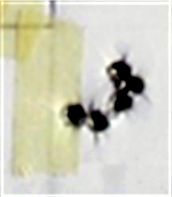
170GC going 1660 fps; and that after not cleaning the gun for some 200 rounds using lead bullet
I briefly tried TiteGroup and Unique, and once Bullseye, but found no promises to continue along those paths. As you may recall, I�m not overly fond of this Ruger American. But its barrel appears quite compatible with lead projectiles.
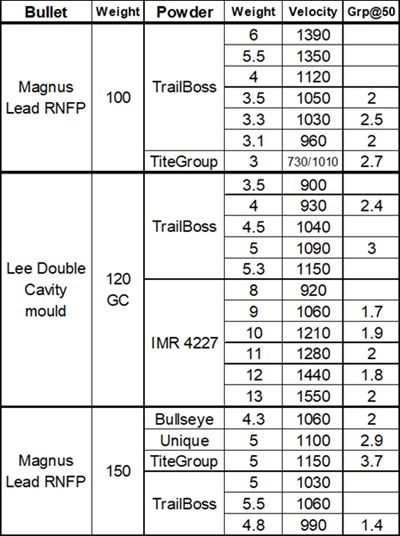
For comparison I also repeated some of these evaluations with a 110, 150 and 170 grain jacketed bullet using the same loads that had resulted in subsonic performance with the lead slugs. Surprise, surprise � the jacketed projectiles left the barrel at much lower velocities.
So, back to the loading bench to put in more powder, and test again. And while I was at it, and since the components were on hand, even sabots carrying 224 diameter bullets got a 300 BLK ride.
Bad idea. My Chrony almost died from the first shot when something, apparently the sabot or a piece of it, hit the display screen. Left a big dent and a disrespected �Err 1� message, but the device continued to work. Of course I got that Chrony out of the way before firing more sabots. Hence, no velocity data for these stunts.
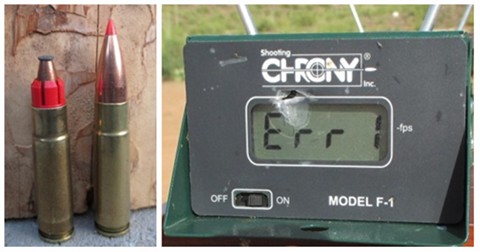
That life can be mean came to light when I inspected the target. For 3 out of 5 shots, the sabot and bullet had not separated, punching a perfect wadcutter hole. And of course the first shot did have separation and permanently deformed my Chrony.
In the end it seemed all for nothing because as the data table below shows, accuracy was nowhere to be found. This called for more violence. I simply increased the powder charge. Separation did result now with every shot, but not accuracy. Ditto for other bullet styles and weights.
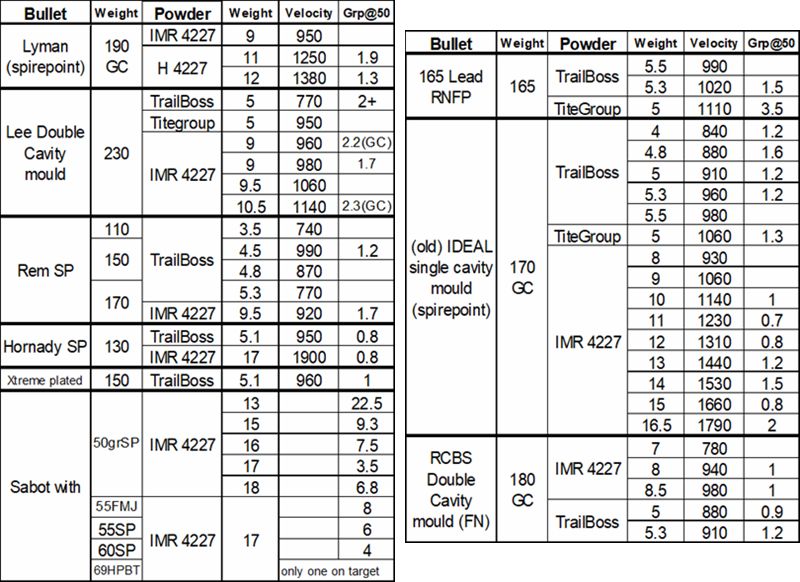
I suppose one more thing to try is to see what would happen if I reduced powder charges. I may do that some day when I have nothing better to do, since I have the components, and they are not of value for anything else. Anyway, utter lack of accuracy appears to be true for any .30 caliber sabot load, and is the reason that nobody offers .30 cal sabots anymore.
Back to some positive stuff and just to remind you, a 300 BLK can be feisty. The 110 grain Hornady Vmax left my rifle at 2320 fps. 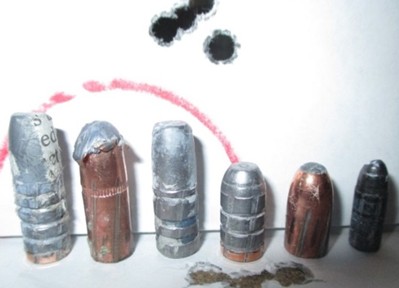
All recovered from wet newspapers (180GC; 170 RN; 165; 120GC; 110 RN). Not unexpectedly, most bullets behaved like FMJs. Only the 170gr Rem RN deformed slightly. That �thing� at the very right is a 60 grain projectile from a 22 LR Aguila Super Sniper, also with no meaningful deformation.
With all that test firing done there was a logical next step. How would at least some of these loads perform under hunting conditions? It took quite a bit of newspaper, then folding and cutting it to size for the containers I used to make a �stack of wet papers� at least 24� deep (long). Then I fired some of subsonic loads into that wet stack.
Bottom Line
So what, really, is a 300 BLK bolt gun good for? I�d say mostly as a plinker. For those who are into casting their own, it can easily be a cheap-on-ammo rig, with options to test things until you�re tired of it. And what about hunting?
Clearly, a 110 Vmax at XXX fps is deadly for anything deer and smaller. At the other end of the spectrum, the small case capacity invites downloaded ammo. TRAIL BOSS and IMR 4227 are great powders for that. Shooting a 100 or 120 grainer with only 3 to 4 grains of fuel makes the outfit sound like a 22LR. Of course even then the 300 has a lot more punch than any 22LR.
And speaking of �punch�, if you are seriously considering to get a bolt gun (or AR for that matter) in 300 BLK, you may want to get a copy of the September 2016 Dillon Blue Press catalog and check out the 7.62x40 WT (pg 44), especially if you don�t mind forming brass. To me that caliber appears to be the optimum 30 caliber based on the 221 � 222 - 223 Rem case. Meaning, it would milk the most knockdown power out of a 223-size case and still fit the AR platform.

Anyway, here�s what I will settle for regarding my 300 BLK, and keep in mind that this Ruger has a threaded snout, and my application for a Sig Sauer suppressor is �in process� � ATF cashed my 200 dollar check on 25 April 2016:
The 110 grain Vmax is earmarked for serious hunting. If I like the outfit enough once the SigSauer can is attached, coyotes watch out! Those 170 GC lead bullets on top of 12 grains of IMR4227 proved themselves as fine and fun plinkers. For instance, when they smack a ten-inch steel plate at 150 steps, the steel rings nicely, giving instant feedback of hit or miss. Finally, for subsonic hunting loads, and for me that mostly translates into squirrels and the occasional cottontail, the 165s and 180s with their flatter noses get the job. They provide more power margin if some bigger critter should show up. Finally, because it feeds flawlessly from the magazine, the 170 gr. cast bullet at subsonic speed will most likely see action once the suppressor is here.
So, there will be a Part 2 to this, when the ATF approval for that SigSauer can finally arrives.
© Honeywell Sportsman Club. All rights reserved.
Source: https://www.hwsportsman.net/300BLK-BoltAction.html